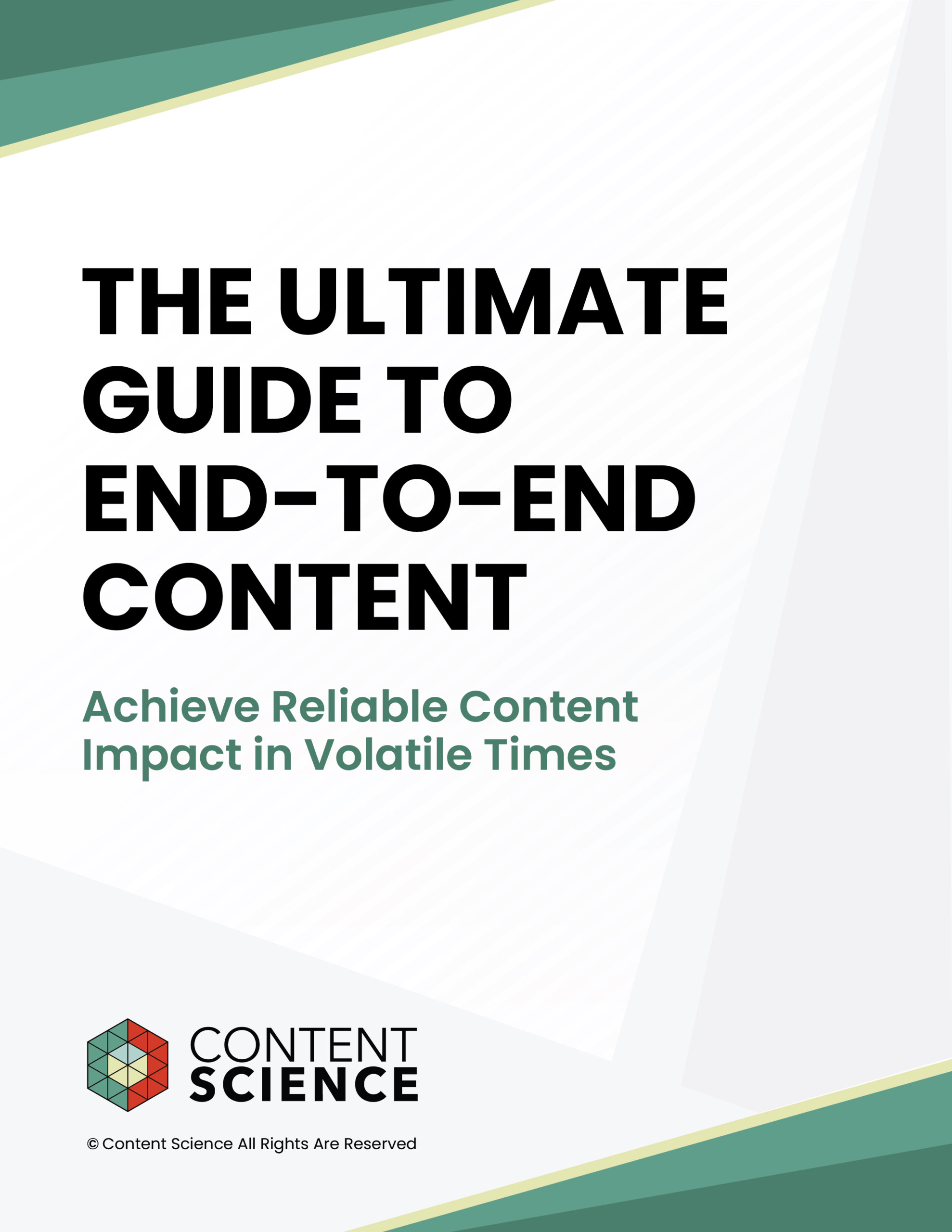
In today’s age of artificial intelligence (AI), enterprises are facing a paradox: Using AI seems simple, but it actually requires highly complex content systems behind the scenes. The temptation to treat AI as a plug-and-play solution is strong. But as leading companies are discovering, sustainable and scalable success with enterprise AI demands mastering—not avoiding—the complexity of content across the enterprise.
This article gives a brief overview of handling content complexity when deploying enterprise AI, including examples, a rethink of the value proposition, and the 6 Ps for E2E Content as a framework for success.
Simple AI Experiences Shift, Not Remove, Content Complexity
GenAI tools can feel magically simple. Whether it’s a chatbot responding instantly or a platform rewriting marketing copy, users often experience AI as seamless. But this simple experience requires deep complexity behind the scenes. AI systems need extensive training data, quality content connected with refined taxonomies and tagging, well-governed workflows, and continuous maintenance to perform consistently, effectively, and ethically.
When enterprises oversimplify the implementation of AI—say, by forcing generative features into existing systems—they risk confusion, low adoption, or even backlash. Consider Mailchimp’s rollout of AI-fueled Intuit Assist. Rather than explore how to enhance and even transform the user workflows as well as leverage the wealth of Mailchimp’s quality content across the customer journey, Intuit Assist was grafted onto Mailchimp’s existing user workflows. Public user complaints on Reddit and elsewhere followed, highlighting how unaddressed content and workflow complexity can derail AI efforts.
So, how do we make sense of this shifting complexity? A framework introduced by Stanford researchers and later applied to AI by researchers from Georgia Tech and Duke can help us. The framework, called GAS (Generality, Accuracy, and Simplicity) illustrates that any system involves tradeoffs. As AI systems become more general (useful in more contexts or scenarios) and accurate for users, they tend to get more complex behind the curtain. We can’t maximize all three dimensions at once. To maintain simplicity for the end user, enterprises must absorb that complexity somewhere else—usually in the form of layered workflows, oversight mechanisms, and robust content governance.
Take Yum! Brands as an example. They own restaurant franchises like Taco Bell, KFC, and Pizza Hut. Recently, they launched a platform called Byte that leverages AI to enable franchisees to do everything from mobile ordering to point of sale applications to menu management to marketing asset management. The franchisees and the customers have positive and productive experiences, and all of the complexity is behind the scenes.
Enterprises also must choose how general they really need their AI systems to be and determine the costs for different tradeoffs. An enterprise can achieve very high accuracy and high simplicity, for instance, in a very specific (not general) context. That’s one reason why small language models are of growing interest to savvy companies.
AT&T, for instance, initially used the large language model GPT-4 to categorize customer service calls and, ultimately, help prevent customers from churning, or leaving. While the approach saved 50,000 customers, it was also expensive and required extensive maintenance. So, AT&T shifted to using a combination of small open-source models such as H2O.ai. Not only does the new approach maintain high accuracy, it works faster and at 35% of the cost with GPT-4.
Let’s consider a few more examples.
Examples of Shifting Content Complexity in AI Deployment
A growing number of enterprise examples shows what happens when large and enterprise organizations embrace complexity—and what happens when they don’t.
Success
- Morgan Stanley empowers financial advisors with an AI assistant trained on a trusted knowledge base, saving millions of hours in productivity.
- Pfizer has cut content creation time by 50% for go-to-market campaigns by defining new workflows and embedding AI.
- Novo Nordisk has reduced the time to draft regulatory documents from 12 weeks to 15 minutes using an AI solution that leverages structured data and governed inputs.
- Cedars-Sinai uses the AI-fueled CS Connect for clinical triage in a way that augments human decision-making without replacing it. They found 77% of AI-generated recommendations across 42,000 patients were optimal.
- Intuit Turbotax uses Intuit Assist, integrated generative AI to automate form autofill, checklist creation, and real-time accuracy checks. Intuit Assist has reduced support contacts by 20% and delivered $90 million in operational efficiencies in the first half of 2025.
- Delta Airlines used AI-powered attribution tools during its 2024 Olympic sponsorship to identify which marketing assets—like the Team USA-themed aircraft—drove over $30 million in ticket sales.
- AT&T uses AI to categorize customer service calls and enable appropriate responses to reduce churn. As I mentioned, the initial deployment relied on GPT-4, and they shifted to a combination of small, open-source models to achieve more efficiency and lower cost.
All of these successes required a significant investment in infrastructure, workflows, content, and human oversight behind the scenes. The following promising examples did, as well.
Promising
- Anthropologie’s early use of AI personalization across email, SMS, and web has shown promising engagement gains, though longer-term results remain in progress.
- Yum! Brands (parent of Taco Bell, KFC, Pizza Hut, and more), as I mentioned, launched the AI-enabled Byte platform to equip franchisees with everything from mobile ordering to point of sale applications to menu management to marketing asset management.
Mixed
- Bank of America‘s chat bot, Erica, has supported more than 2 billion client interactions since launching, but it has required more than 50,000 updates and enhancements. It currently does not use gen AI, only machine learning and natural language processing AI, due to concerns about the risks.
- Walmart has deployed an agentic assistant for 50,000+ associates to boost employee productivity—and has uncovered many challenges with governance and oversight.
- Intuit Mailchimp has experienced user backlash against shoehorning Intuit Assist into its existing workflows and interface. What works in one product doesn’t necessarily work in another, which adds to the challenge of scaling AI.
Failure
- Air Canada’s chatbot created and enforced a fake refund policy in the case of bereavement, resulting in a court ruling and reputational damage—highlighting the risks of deploying agentic AI without proper oversight.
These outcomes reveal a pattern: Organizations that handle content complexity thoughtfully see returns in efficiency, trust, and innovation. Those that bypass complexity pay an unexpected price.
The Enterprise AI Value Shift: From Productivity to Transformation
When we start to understand the role of complexity in deploying enterprise AI, we also can better appreciate and articulate its potential value. It’s tempting to evaluate enterprise AI investments solely through the lens of productivity—faster document creation, fewer customer service hours, streamlined workflows, and the like. While those gains can be real, they are often the smallest part of the long-term return.
The true value of deploying AI lies in business transformation and innovation. Smart enterprises aren’t just shaving hours off tasks—they’re reimagining what’s possible. Pfizer isn’t just producing content faster; it’s enabling more consistent, personalized, and scalable go-to-market experiences. Yum! Brands isn’t just accelerating campaign creation—it’s building a global content engine that can adapt to 150+ markets in real time. Novo Nordisk didn’t just shorten regulatory drafting; it redefined compliance responsiveness in a highly regulated industry.
These organizations understand that AI is not merely a cost-cutter—it’s a capability multiplier. AI helps unlock new ways to serve customers, enter markets faster, and adapt to complexity at scale. And none of that is possible without sophisticated content strategy and mature, well-governed content operations that support this transformation.
Enterprises focused only on productivity may miss the bigger opportunity of longlasting competitive advantage through innovation.
Three Barriers Holding Enterprises Back in Scaling AI Success
1 Repeating Past Digital Transformation Mistakes
Like past digital transformations driven by other technologies, some AI initiatives are myopically focused on the technology. Without a comprehensive vision, cross-functional buy-in, and support of end-to-end customer journeys, AI-driven transformation can flounder and fail.
2 AI Uncertainty: Risks + Value
Concerns over data privacy, hallucinations, IP leakage, regulatory compliance, bias, and much more are real—and growing. Transparency, bias mitigation, and governance are no longer optional. And neither is developing good judgment about the tradeoffs between generality, simplicity, and accuracy.
3 Immature Content Strategies + Operations
Many organizations lack the people, processes, and platforms to manage content at scale. They also often have significant content debt, such as content lacking sufficient structure with metadata, outdated content, content falling short of standards, and little documentation of content models, guidelines, or worksflows.
The Path Forward: E2E Content Strategy + Operations
To navigate this complexity, leaders must embrace end-to-end (E2E) content strategy and operations. In The Content Advantage, I explain the 6 Ps framework, which has helped a range of organizations handle the inevitable complexity shift in deploying AI.
The 6 Ps Framework from The Content Advantage
A brief overview of the 6 Ps for E2E Content includes
- Problem – Start with a clear understanding of challenges and opportunities in both content and customer experience.
- Plan – Define a compelling vision, strategy, and roadmap for AI-driven transformation. Factor in the GAS tradeoffs.
- Persuasion – Set standards and examples for effective, influential content and train both humans and AI accordingly.
- Power to Scale – Mature content operations: roles, processes, and technologies.
- Prudence – Establish content intelligence by using data to inform decisions, optimize strategy, and continually improve.
- Perseverance – Strengthen content governance, lifecycle management, and systems engineering to ensure long-term integrity.
This model isn’t theoretical. It’s battle tested. For instance, a major IT company used it to launch a new cloud platform, scaling from fragmented touchpoints to a unified customer experience supported by reusable content types, templates, and analytics frameworks.
And the framework applies to more than marketing; it spans the full customer and employee experience. The 6 Ps account for both human oversight and AI potential, from scalable content reuse to regulated communications and much more.
The Power of Partners
Navigating this new complexity isn’t something organizations have to do alone. Strategic partners like Content Science can accelerate progress by guiding an organization in assessing their content and AI situation, crystallizing their vision, forming a sophisticated strategy along with an achievable roadmap, and maturing their operations. Whether supporting The Home Depot’s retail evolution or helping Dell realign cloud CX content for APEX, Content Science brings cross-industry expertise and a proven playbook to bear.
From Uncertainty to Opportunity
Enterprise leaders can move beyond reactive, surface-level AI experimentation with meager productivity gains. Mastering complexity, especially content complexity, is the difference between shiny demos and sustainable transformation that brings longlasting value.
With a sophisticated approach, clear standards, and smart partners, enterprises can turn the unknowns of AI and the complexity of their businesses into strategic advantage. In a world where content is both the input and output of AI, content maturity is business maturity—and the key to success.
Events, Resources, + More
The Ultimate Guide to End-to-End Content
Discover why + how an end-to-end approach is critical in the age of AI with this comprehensive white paper.
The Content Advantage Book
The much-anticipated third edition of the highly rated book by Colleen Jones is available at book retailers worldwide. Learn more!
20 Signs of a Content Problem in a High-Stakes Initiative
Use this white paper to diagnose the problem so you can achieve the right solution faster.
Upskill with Content Science Academy
Training for modern content roles through on-demand certifications + courses or live workshops.







Comments
We invite you to share your perspective in a constructive way. To comment, please sign in or register. Our moderating team will review all comments and may edit them for clarity. Our team also may delete comments that are off-topic or disrespectful. All postings become the property of
Content Science Review.